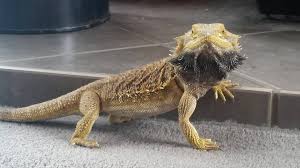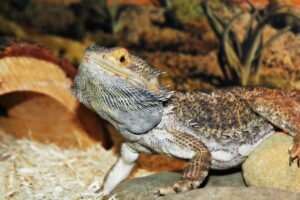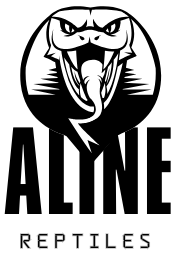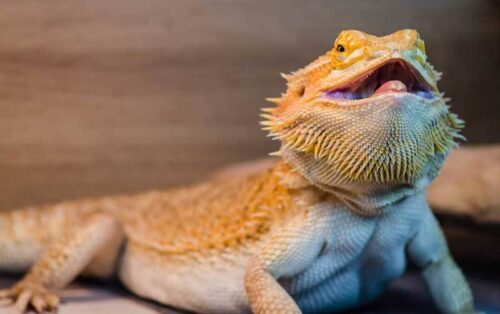Bearded dragons are among the most popular pet reptiles, known for their unique appearance, docile nature, and fascinating behaviors. However, like all pets, they can experience stress, which can manifest in various physical signs. One of the most noticeable of these signs are bearded dragon stress marks, a common issue among bearded dragon owners.
If you’re noticing dark patches or discoloration on your bearded dragon’s skin, you may be witnessing stress marks. These marks, while often temporary, can indicate that something in their environment is amiss. Understanding what causes them, how to identify them, and how to manage them is essential for every bearded dragon owner.
Whether you’re a new owner or have had your bearded dragon for years, this guide will provide you with the information you need to take proactive steps in ensuring your pet’s health and happiness.
In this comprehensive article, we will explore the causes, identification methods, and ways to reduce stress marks, alongside other important considerations for maintaining a healthy and happy bearded dragon.
What Are Bearded Dragon Stress Marks?

Stress marks are dark or discolored patches that appear on the skin of a bearded dragon when they are stressed or anxious. These marks are typically found on the underside of their bodies, around their limbs, or near their neck and chin. Stress marks can appear as darkened areas that might look similar to bruising or as irregular spots on the bearded dragon’s skin.
Natural vs. Stress Marks
Bearded dragons have naturally occurring patterns and colors on their skin that vary by species, age, and individual characteristics. These natural markings often serve as camouflage or a form of communication.
Stress marks, on the other hand, are usually a temporary phenomenon triggered by an external factor. They are not a permanent feature of the dragon’s body, but they are a sign that something is causing the animal discomfort or distress.
While stress marks often fade once the stressor is removed, it is important to observe their frequency and duration. If the stress marks are persistent or accompanied by other concerning symptoms, it might indicate a more serious health issue that requires attention.
Common Causes of Stress Marks
Understanding the root causes of stress marks is key to helping your bearded dragon live a stress-free life. There are several factors that can trigger stress in bearded dragons, from environmental changes to improper handling. Let’s take a look at the most common causes:
1. Environmental Factors
One of the leading causes of stress marks is an improper environment. Bearded dragons are desert-dwelling creatures and require specific conditions to thrive. If these conditions are not met, stress marks are likely to appear.
- Incorrect Lighting: Bearded dragons rely on UVB lighting to synthesize vitamin D3, which is essential for calcium absorption. Without proper lighting, they may become stressed, leading to stress marks. UVB bulbs should be replaced every 6 months, as their intensity diminishes over time.
- Temperature Fluctuations: Temperature plays a huge role in a bearded dragon’s well-being. If the enclosure is too hot or too cold, it can cause stress. The basking spot should be between 95°F to 105°F (35°C to 40°C), while the cooler side should be around 75°F to 85°F (24°C to 29°C).
- Improper Humidity: While bearded dragons come from dry climates, they still require proper humidity levels, typically between 30% and 40%. Too much humidity or too little can stress your bearded dragon, causing them to develop stress marks.
- Lack of Hiding Spots: Bearded dragons need a place to hide to feel secure. If their enclosure lacks enough hiding spots, they may feel exposed and stressed, leading to the appearance of stress marks.
2. Handling and Interaction
Bearded dragons, though generally calm, are not immune to stress from excessive handling or rough interaction. This is particularly true if your pet feels threatened or unsafe.
- Over-handling: While bearded dragons are relatively easy to handle, too much handling can stress them out, especially if done improperly. Handle your bearded dragon gently and for short periods, allowing it to acclimate to your touch gradually.
- Rough Handling: Picking up your bearded dragon too quickly or without supporting its body properly can make it feel vulnerable and stressed. Always support its belly and legs when picking it up.
- Frequent Changes in Environment: Moving your bearded dragon’s enclosure or introducing new pets or loud noises can cause stress. Bearded dragons thrive in a stable environment and become stressed when there are too many changes too quickly.
3. Health-Related Issues
Stress marks may also be an indicator of underlying health problems. While it’s common for bearded dragons to experience stress due to their environment, illness can sometimes cause stress as well.
- Parasites: Internal or external parasites can make your bearded dragon feel unwell and stressed, leading to stress marks on their skin.
- Dehydration: If your bearded dragon isn’t drinking enough water, they can become dehydrated, which may lead to stress marks along with lethargy and a lack of appetite.
- Metabolic Bone Disease (MBD): This condition, which arises from a lack of calcium or improper UVB lighting, can cause stress and other symptoms such as twitching, lethargy, and deformities. Stress marks might appear alongside these symptoms.
4. Breeding or Hormonal Changes
Breeding and hormonal changes can also play a role in the appearance of stress marks. Female bearded dragons may show stress marks during mating season, and males may develop them when they are overly territorial or agitated.
How to Identify Stress Marks in Bearded Dragons

Physical Characteristics
Stress marks are typically dark, irregular patches or stripes that appear on the skin of a bearded dragon. These marks may be more pronounced on the underside or along the limbs. Stress marks can range from a deep, dark color to a light grey or brown hue, depending on the severity of the stressor.
Here’s a simple table to help you distinguish stress marks from other potential health issues:
| Condition | Appearance of Stress Marks | Other Symptoms |
|---|---|---|
| Stress Marks | Dark or irregular patches on the skin. | Behaving nervously, frequent hiding. |
| Dehydration | Dry, wrinkled skin, sunken eyes. | Lethargy, loss of appetite. |
| Metabolic Bone Disease | Soft or bent limbs, swelling near joints. | Weakness, twitching, lethargy. |
| Parasites | Darkened areas on the skin, occasionally with other marks. | Lethargy, loss of appetite, weight loss. |
Behavioral Signs
In addition to physical changes, you should also monitor your bearded dragon’s behavior to assess its stress level. Common behavioral signs of stress include:
- Increased hiding: A stressed bearded dragon may hide more frequently, avoiding interaction.
- Glass surfing: If your bearded dragon is pacing back and forth along the sides of its enclosure, it could be a sign of stress.
- Basking irregularities: A stressed bearded dragon may either refuse to bask or may bask excessively, trying to regulate its body temperature.
How to Reduce and Prevent Stress Marks
1. Creating a Comfortable Habitat
A proper habitat is the first step in ensuring your bearded dragon feels secure and comfortable. Here are some essential habitat tips:
- Temperature: Keep the basking area between 95°F and 105°F (35°C to 40°C), and the cooler side between 75°F and 85°F (24°C to 29°C).
- Lighting: Provide UVB lighting for 10–12 hours a day. Consider using a combination of heat lamps and UVB bulbs to mimic the sun’s natural cycles.
- Humidity: Maintain a humidity level of 30-40%. You can regulate humidity with a hygrometer and mist the enclosure lightly if necessary.
- Hiding Spots: Include a variety of hiding spots in your bearded dragon’s enclosure. This gives them a place to retreat and feel safe when they need it.
2. Handling Tips
- Gentle Handling: When picking up your bearded dragon, do so gently and support its body well. Avoid picking it up by the tail, as this can cause discomfort.
- Acclimate Gradually: If your bearded dragon is new, give it some time to adjust to its new environment before handling it too much.
3. Feeding and Diet Tips
Bearded dragons require a balanced diet to stay healthy and reduce stress:
- Leafy Greens: Provide a variety of leafy greens such as collard greens, mustard greens, and dandelion greens.
- Insects: Feed your bearded dragon a variety of insects like crickets, dubia roaches, and mealworms. Make sure the insects are gut-loaded to provide extra nutrients.
- Supplements: Dust their food with calcium and vitamin D3 supplements to support bone health and reduce the risk of metabolic bone disease.
Is It Time to Seek Professional Help?
If your bearded dragon’s stress marks persist despite environmental changes or if you notice other symptoms such as lethargy or unusual behavior, it may be time to consult a reptile vet. Some signs that professional help is needed include:
- Persistent stress marks despite attempts to reduce stress.
- Behavioral changes like extreme lethargy, lack of appetite, or abnormal movements.
- Physical deformities such as soft bones, swollen joints, or a noticeable change in posture.
Conclusion
Bearded dragon stress marks may seem alarming at first, but they are often a sign that something in their environment needs attention. By understanding the causes of stress, identifying stress marks early, and taking the necessary steps to reduce stress, you can ensure your bearded dragon leads a happy, healthy life.
With the right care and attention, your bearded dragon can live without the discomfort of stress marks, thriving in an environment that meets their specific needs.
By implementing the tips and strategies discussed in this guide, you can not only manage stress marks but also promote the overall well-being of your beloved reptile. Stay observant, be proactive, and keep learning about your bearded dragon’s unique needs—after all, your pet relies on you for a safe and comfortable life.

